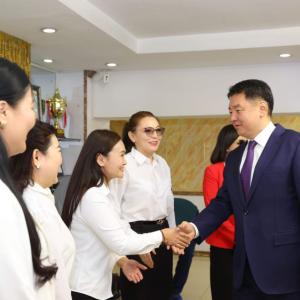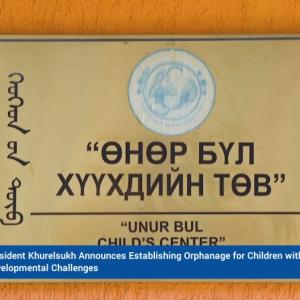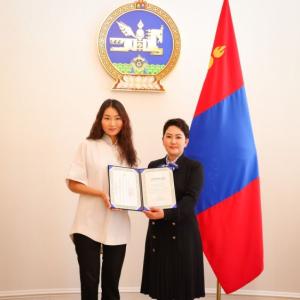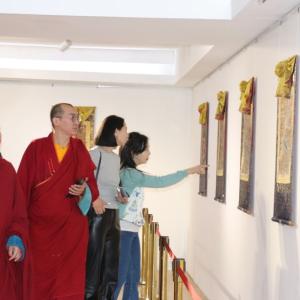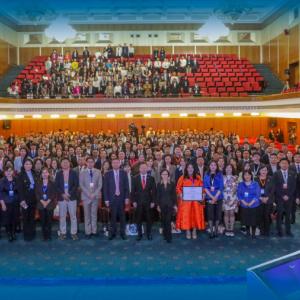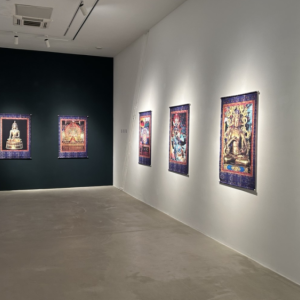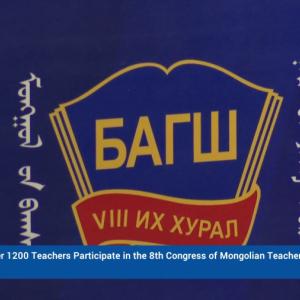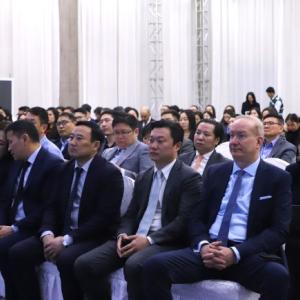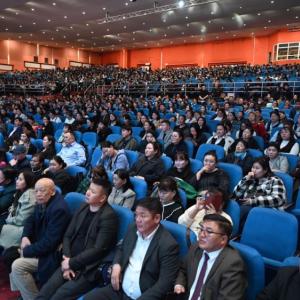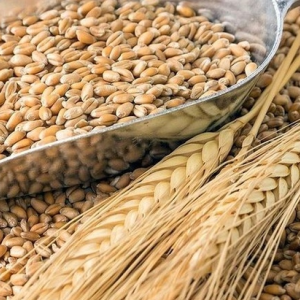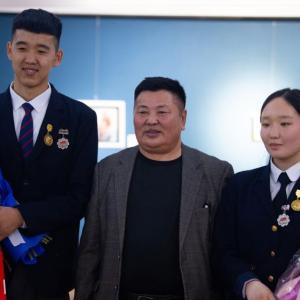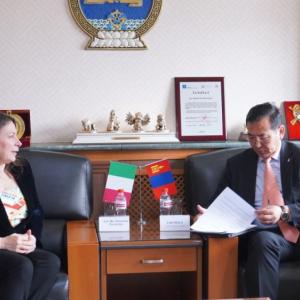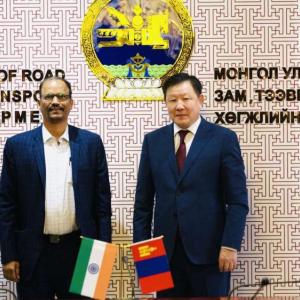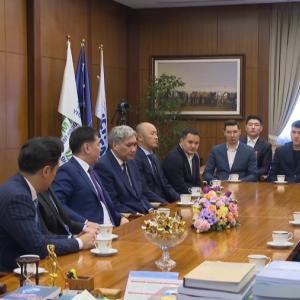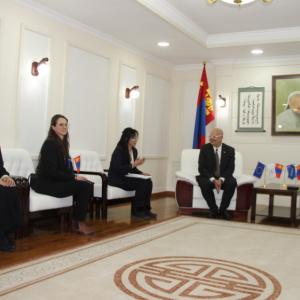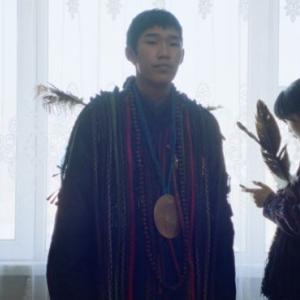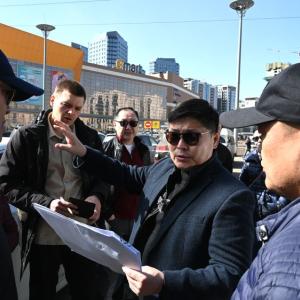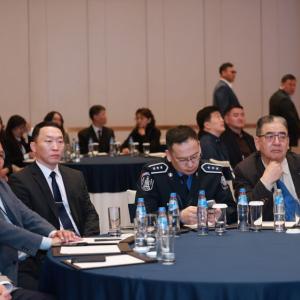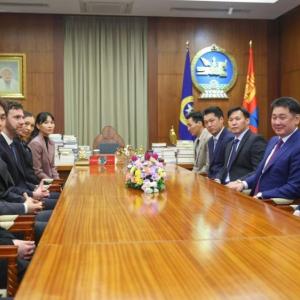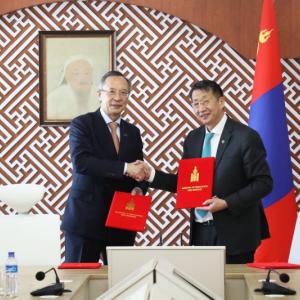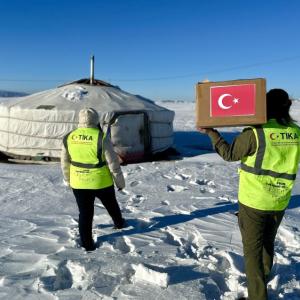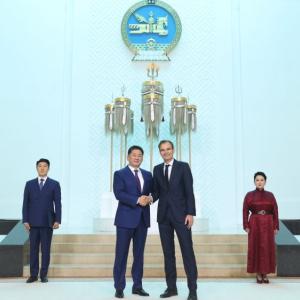Education
In the early days of Mongolian history, education was primarily provided by the religious and royal institutions. Buddhist monks gave basic education to boys in classes set up within the compounds of monasteries, while children of the royal household and from families of the nobility were educated in order to serve in the court and be hereditary.
After the victory of 1921 People’s Revolution was increased recognition of the need for educated people for the development of the country. As a result, the Mongolian education system was modernized and made more accessible to the general public. It| was strongly influenced by the former Soviet Union system and in which two educational paths were stipulated: the academic and the vocational
Before socialism in Mongolia, literacy was widespread in monasteries and for government officials. Informal skills were learnt at home and passed on through the family. Some children were taught a language to communicate with neighboring countries or were taught to recite Buddhist texts. Formal education was exclusive and selective.

The 1921 People’s Revolution opened up public education, giving people the right to free education regardless of gender, ethnicity or wealth. By the 1930s, schools as formal places of learning for all were opened in administrative centers across the country. Dormitories were built for children of nomadic families, with food, clothing and tuition provided by the state. Education was uniform, centralized and available to all. By the mid-20th century, literacy had increased drastically; with the shift from traditional Mongolian script to Cyrillic, teachers were sent out to teach everybody to read and write. For most children in this era, education (mainly based on Russian pedagogical teaching methods) was something that did not only take place at school; pioneer activities gave moral and practical teaching outside the formal school environment. Country cooperatives, looking for maximum productivity, ensured that all the state took care of all aspects of a child’s education, leaving parents free to work. By the 1960s, illiteracy was almost eradicated nationwide, which was recognized by UNESCO.
In the early 1990s, the national economic situation country had changed radically, and the transition to an open market economy hit the centralized education system severely. Starting in 1991, enrolment in kindergarten dropped radically from two-third to one-third of pre-school aged children. Enrolment in general education was nearly universal in 1990, dropped during the economic crisis of 1992-1994, and slowly recovered in the subsequent years.
From the late 1990s, the educational situation began to improve. One influence was the ministry’s education sector development program, which began in 1997, funded by ADB loans and grants. This aimed to improve the quality and cost-effectiveness of the education system, and restructure education institutions. It has resulted in a sound secondary and higher education system Laws introducing innovation in education since 1995 have made it possible to change the education system and content to match those of more developed countries, enhancing the quality of all education, upgrading equipment and facilities and raising student social guarantees. of education. Mongolia elementary education is universal and largely free, and the country boasts one of the world’s highest literacy rates (claimed to be 97.8 per cent).
Preschool education
Preschool education that is, nurseries and kindergarten cover the age groups of 2 to 6-year olds. This sub-sector includes both formal education in the form of nurseries and kindergarten as well as non-formal education in the form of multi-week school preparation programs, typically offered in June, when the school year ended and before the start of the new school year (September 1).
General Education
General education starts at age 6. From 2015, Mongolian children enroll in school at age six for 12 years (5-4-3) of education. The Government of Mongolia identified the main goal of education quality reform policy as a Mongolian capable to make creative decisions about who shall build a world competitive-knowledge-based society. In this light, the ‘Right Mongolian Child’ program was approved which is included in the curriculum of preschools, primary and basic education schools. The Government of Mongolia spends one-forth of its revenue on education. In the 2015-2016 academic years, 64,364 children enrolled in first grade of the secondary schools. Vocational and technical education (VTE) includes both specialized upper secondary schools (grades 10 and 11) as well as post-secondary diploma programs housed in vocational training centers.
Higher Education
After the 1921 People’s Revolution, the best students were sent to Russia or other countries. In 1926, 40 Mongolian students went to Germany and France for college education, becoming the first Mongolian intelligentsia. The first tertiary institution, the State University (today’s National University of Mongolia), was inaugurated on May 5, 1942. Its first academic year began on October 5, 1942, with 93 students in three faculties and 57 graduate students. In 1951, the teacher training faculty was hived off as the State Pedagogical Institute, with four faculties, eight lecturers and 212 students. It is now the Mongolian State University of Education. The zoology faculty in 1958 became the independent Agricultural Institute and the medical faculty became the Medical Institute in 1961. By 1966, the State University had the Technical Institute, with five faculties and 13 departments, which later became a University. The faculty of Russian language took its place in 1979.
Nowadays higher education sub-sector: institutes, colleges and universities. Colleges provide three-year diploma programs and four-year programs at the Bachelors level. Universities offer Bachelors, Masters, and Ph.D. programs.
For the first time in Mongolia, masters program of international business administration (MBA) is being offered. It is delivered through the Mongolian Institute of Finance and Economics (IFE).
The Government takes various measures towards making structural and program reforms in universities, empowering teaching personnel, and creating jobs for graduates. Furthermore, great focus is being made to train 1000 engineers and students in developed countries, founding hospitals at medical universities, providing scholarships, covering students’ health insurance premiums by the government, regulating their transportation issues and so on.
Non-formal education and distance education
The non-formal education sector caters to two groups. The primary target group consists of those with no or limited formal schooling, that is, school-aged children and youth that are out-of-school as well as adults that never enrolled in or dropped out of schools. The second target group is more broadly defined and includes literate adolescents and adults that take courses in life skills courses (e.g., on health, market economy, legal education, ecology, small-business skills), vocational skills, creative skills, or in other areas (parenting, how to generate additional income, etc.). Since the establishment of the National Program for Non-Formal Education in 1997, the number of non-formal education centers catering to literate adolescents and adults increased steadily.
Students with special needs
Students with special needs: There exist countrywide five schools for students with severe physical or mental disabilities, all located in Ulaanbaatar. Officially, students with special needs are supposed to be integrated in regular schools. However, there is no national program or policy to systematically integrate students with special needs in schools, and as a result their integration depends on the goodwill of the individual school. The more common form of schooling for children that have special needs is home schooling by parents and, if private financial resources are available, private tutoring by teachers.
There also exist numerous classes at lower and/or upper secondary level for students that are especially gifted. The majority of them are classes within a regular school, but in greater agglomerations, there also exist separate schools for gifted students. They provide additional courses in particular subjects for a fee that is retrieved from parents. The most 16 popular subjects are the natural sciences. High-stakes entry exams are used to ensure a selective admission. There is no statistical information available on the number of classes and schools for gifted students.
Science
Mongolia has a tradition of respect for knowledge and wisdom. Chinggis Khaan summoned scholars to The Council of Sages, highly respected helping run the state and domestic and foreign policies. Members were ranked according to function; for instance, some had to record the Khaan’s orders or announce them to the people. In 1264, Chinggis’s grandson Khubilai Khaan founded the Institute of Learned Scholars, from which came the concept of Academy. Here, all the wise with their own tasks and duties were ranked and named.
Traditional science
The origin of science in Mongolia is related to the nomadic way of life, which lasted many centuries, although the culture of settled nations has had a huge impact on development of Mongolian naturalistic and scientific knowledge.
Animal Husbandry. Experience accumulated by herders in pastoral stock breeding, enriched from one generation to the next, became the foundation of a body of systematic knowledge. This concerned the earth and nature, biology, ecology and ethnology, a basis for folk methods of selection, preservation and multiplication of the livestock gene pool. Mongolians had a great ability to run animal husbandry with the best possible results with the lowest possible input of effort and resources. Knowledgeable about nature, the climate and weather, they worked out their own unique ways of livestock breeding, methods of pasturing and watering in various seasons, rearing young stock and using animals for different purposes.
They developed the art of processing animal produce in nomadic conditions. The herders carefully preserved all knowledge and used it effectively in their daily practices, passing it on orally, enriched with their own experience. Through many centuries, Mongols accumulated a mass of practical knowledge by trial and error. This could be termed a folk science, and had a very close and important interrelationship with the enormous corpus of knowledge amassed by the lama scholars. Lamas sought to systematize material things and natural phenomena and to fuse theoretical knowledge with the practical experience of the herders. A sutra thought to have be from the seventeenth century defines the qualities of a horse based on internal organs (heart, kidneys, liver, spleen) and on external organs (eyes, nose, ears, tongue and gums). It describes a correlation between different characteristics of domestic animals, as established over the centuries. For a sire, herders considered over 30 characteristics for colts, the same number for camels and at least ten for bulls. In modern terms, this was determining the evolution of genotypes by their phenotypes.
Astrology and Astronomy. While enriching ‘bookish science’ with their orally-transmitted practical experience, herdsmen also adopted previous experience recorded in writing with their systematized knowledge of the phases of the moon, the sun, meteorological phenomena, and the qualities of different grasses and plants. In treating animal diseases, herdsmen used acupuncture, phlebotomy and medicinal herbs, with methods borrowed from the lamas. Ancient mathematical, astronomical and medical observations and generalizations served as a primary source of scientific cognition of the world by nomadic Mongols. Particular significance was attached to astronomy, which gave an idea of space and reference points of practical value in nomadic farming. Evidence of the deep-rooted mediaeval Mongol knowledge of astronomy is a map of stars, now in the National Library. It shows 1,375 stars: 773 from the northern hemisphere, 602 from the southern hemisphere, in 229 constellations. Each had its own name, indicating the relatively high level of Mongol astronomical knowledge. Many works of astronomy and mathematics by Mongolian authors like Luvsan-Danzan-Jaltsan (1639-1704), Myangat (1685-1770), Luvsantsultem (1740-1810), Luvsan-lhiindev, Yadam, Luvsan-Tsultem-Jamtso (19th century) Ovgonhuu, Jambalsharav, Chanrav, Choijiljav (20th century) have survived. Sumbe-Hamba Ishbaljir and Ovgonhuu devised new ways to measure the movements of the sun, moon, planets and other heavenly bodies, in which they took into consideration geographical location. One major Mongolian mathematician was Myangat. After 30 years of research on the formula for the differentiation of trigonometric functions, he compiled a four-volume book, Concise Method of Determining Pi through the Intersection of a Circle. This offered a way to solve a given formula which was entirely new at the time. It is noteworthy that Myangat rejected the geocentric system of the world. Mongolian Calendar. Zurhain Ukhaan (the art of calculating and drawing), an original form of astronomy, may rightly be regarded as a significant nomad accomplishment. Although this is quite often associated with astrology, it was in fact rather more, providing ways to calculate the coordinates of heavenly bodies and the times of lunar and solar eclipses. Astronomical data were primarily used in compiling calendars. The old Mongolian calendar was cyclical, lunar-solar, based on a cycle of 60 years, divided into five cycles of twelve years. These years were named after different animals: mouse, ox, tiger, hare, dragon, snake, horse, sheep, monkey, cock, dog and pig. These in turn had five elements (fire, water, earth, wood, iron) and corresponding colours. The years alternated according to gender: mouse, tiger, dragon, horse, monkey and dog were male, and ox, hare, snake, sheep, cock and pig were female.
Traditional Medicine. Mongolia developed an extensive, distinctive branch of oriental medicine, chiefly using animal and herb preparations.
 In the Middle Ages, folk pharmacology merged with Tibetan medicine, becoming one of the offshoots of oriental medicine, but bariachiin urlag (surgery), sometimes wrongly narrowed to bone-setting, retained its unique path of development until recent times.
In the Middle Ages, folk pharmacology merged with Tibetan medicine, becoming one of the offshoots of oriental medicine, but bariachiin urlag (surgery), sometimes wrongly narrowed to bone-setting, retained its unique path of development until recent times.
Scores of books on Mongolian medicine were written between the 16th and 20th centuries. Best known are those by Luvsan-Vanjil (18th century), Jambal (18th-19th centuries), Choibol (19th century) and Ish-Danzan-Vanjil, Yondon, Dandar and Choijamts (19th to 20th centuries). A distinctive feature of Mongolian medicine is that while based on a combination of theory and practice of two trends in medicine (Indian and Chinese), it has also absorbed traditions of indigenous folk treatment methods.
Mongolian doctors determined the anatomy, physiology and treatment of diseases, and the effect of medicinal substances and psychosomatic yoga, by the five basic elements of Indian philosophy (earth, water, fire, air and space).
At the same time, taking the pulse, acupuncture, cauterization, phlebotomy, interaction of the five organs and their function, and season and time cycles were determined on the basis of the five elements of Chinese astrology (fire, water, earth, iron and wood).
Mongolian doctors would raw up a picture of the general state of a patient’s entire body.
This also involved partial hangs in organ activity and possible resultant deviations, then chose and applies a comprehensive and highly individual course of treatment.
They had a quite accurate assessment of medicinal preparations and their curative properties, knowing where to look for medicinal herbs, and when and how to collect and process them.
Mongolian medicine, which prescribed extensive use of medicinal plants and mineral substances, had a noticeable influence on the development of Indian, Tibetan and other branches of oriental medicine.
In pre-revolutionary Mongolia, there were several Otochiin Datsan (schools of medicine) where a select group of lamas taught oriental medicine.
Many of these lamas wrote their own books on medicine in Tibetan and Mongolian.
Jambaldorj, a well-known 19th century Mongolian doctor, compiled a vast treatise on pharmacology and pharmacogenesis, describing medicinal plants growing in Mongolia and medicines of animal and mineral origin, with drawings and illustrations of 576 plants and herbs.
The names of the preparations were given in Tibetan, Chinese, Mongolian and Manchurian.
In 1921 the Literary Committee was established, predecessor of the Mongolian Academy of Sciences (MAS), which was born in 1961.
Until the end of the 20th century, the Academy worked within the standards of similar organizations of the former USSR. Science entered the 21st century aware that the speed of world scientific and technological development was high, and that new external conditions were coming into force.
Over the past 90 years, Mongolian geologists have located over 80 different mineral deposits and produced geological, geotectonic and hydro-geology maps. Classification, analysis, location and development and history of 700 million years of the main periods of the organic world have been made, and maps for seismic activities drawn up.
Research into physical mathematics, nuclear and space physics, biophysics and observation of latitude and longitude has been carried out, and 119 new medicinal plants have been discovered.
A catalogue of Mongolian mammals, birds, fish and about 9,000 insects has been amassed.
The MAS has published a Mongolian National Atlas, the Mongolian Red Book, and a five-volume Mongolian history.
Mongolia ranks third in the World with its paleontological research achievements. Since the expeditions of Roy Chapman Andrews found dinosaur eggs in Gobi some ninety years ago, the Gobi Desert of Mongolia is known to be one of the world’s greatest sources of dinosaur fossils. Each year, international expeditions come to Mongolia to search for dinosaurs among the Gobi’s spectacular sandstone buttes and wind-blown dunes. According to research of our paleontologists 3-4 new genus and species of these ancient mammals are discovered in our country each year. Starting from 1985, Mongolian scientists have displayed their paleontological exhibitions in about 80 cities of 20 countries.
Did you know?
That the first dinosaur egg was discovered in Mongolia in 1922.

Modern medical branches like space and human genetics have been developed. The Mongol gene pool has been studied and a new human gene discovered, registered by the WHO.
Foreign relations with Mongolian science are expanding, and Mongolia is working with scienctific organizations in 20 countries, including the US, Russia, the UK, China, Germany and Korea.
Mongolian scientists and engineers are continually creating highly innovative competitive products. Most recently, surgical thread made from animal tendons by Doctor S.Tugs, a Professor of the Mongolian University of Science and Technology caught the world’s attention. Meanwhile, a hybrid energy system that increases residential energy efficiency, created by Mongolian engineers attracted public attention as well. A team of the ‘Organic Energy’ Group and the ‘Green City’ Association made the equipment with the goal of reducing air and soil pollution, creating appropriate energy consumption and expanding renewable energy usage. The energy system took a long time to be developed by highly skilled and proficient engineers Kh.Unur-Otgon, N.Galbadrakh and others. Annually, It takes 14,380 kilowatts of energy to heat a Ger with a five walls (traditional dwelling house) and ger residents (the main resource of Ulaanbaatar air pollution) pay Tgs 301 thousand every year to the Ulaanbaatar Electric Transmission Company-electric provider company. But, the payment can be reduced to Tgs 63 thousand if the above equipment is used.
‘Erdenet khivs (carpet)’ company jointly with Mongolian University of Science and Technology (MUST) started to fabricate smart textiles using nanotechnology developed by a Mongolian scientist. On November 29, 2014, the smart textile factory opened officially. The textile is called ‘smart’ as it is resistant to dust, water and other liquids although it can breathe thanks to nanoparticles discovered by Dr. and Assistant Professor Rentsenlhundeviin Myadagmaa, Mongolian Textile institute at the school of Industrial technology and design of MUST.
Scholars and scientists from various generations are involved in Antarctica research. Particularly, weather prognosticator and scientist J.Tserendeleg worked in Antarctica from 1972 to 1974 and carried-out research on the upper atmosphere for the first time from Mongolia. In 1982- 1984, D.Chuluunbat conducted upper atmosphere research and in 2007, A.Batbold, officer of the Information and Research Institute of Meteorology, Hydrology and Environment of Mongolia performed meteorological and hydrological research. Moreover, L.Dugerjav carried-out geological research on a glacier in 2008 2012 and became the first Mongolian to land at the Amundsen–Scott South Pole Station, United States scientific research station at the Geographic South Pole, the southernmost place on Earth.
At that time, he set the location for the Mongolian research station. Since then, works related to the research and establishment of the Mongolian base stations have been executed. Afterwards, D.Ganbaatar carried out research on possibilities to establish a research base for Mongolia in 2013 and Kh.Purevdagva, carried-out hydrology and climate research with an international research expedition and raised the Mongolian flag on the South Pole. As a result of the research, works to determine the location of Mongolia’s research station and other corresponding works were moved forward.

is at the point where Mongolian Research Station to be built. On January 15, 2015, was reached Livingston
Island, Antarctica with the Bulgarian expeditionto conduct research works.
Mongolia ratified the Antarctic Treaty on March 23, 2015 as its 53rd party, after the Foreign Ministry took the issue into consideration and submitted the issue to for Cabinet and Parliament discussion. At this time, about 20 countries are conducting research on the continent
Since 1998, parliament has developed science policies, approving laws on science and technology and on technology transfer, with laws for the work of scientific organizations.
MAS has 49 organizations, comprising five in technological sciences, three in natural sciences, five in agriculture, four in medicine, 15 for social science and 10 research, experimental and production corporations.
Mongolians have studied their history, language and culture, identified special features of its nature and climate, and investigated its natural resources.
They have also identified new plants and animals, and have diagnosed, treated or preventing many human and animal diseases.
In 2002, a National Information and Technology Park was opened to support the development of high technology, and business is helped with a Science Support Fund.
Culture
Literacy
Mongolia is an oriental country with an ancient and unique culture. Its national script is said to have been one of the six most recognized alphabets in the world at the time. The earliest monument, the Chinggis’s Stone Inscription, dates back to over 1200. It was dedicated to Esunkhui, a hero who hit every target from 500 meters during a contest when Chinggis Khaan was celebrating victory over the Sartuul tribes. In 1204, by order of Chinggis Khaan, Mongolian script was given national status. In the period until early 20th century, the Mongolian nation used a total of six scripts. Of them, four were created and used by Mongolians themselves. These are:
- Uigur script had primarily been used early 10th century from the Naiman tribes, the history attests. While developing though many centuries, the script had been used until 1940.It was Uigur script in which the richest historical and cultural heritage of Mongolians had been created. Well known is the above “Stone Inscription.
- Soyombo script created by Undur Gegeen /the Lofty Saint/Zanabazar (1635-1724). The script consists of about 90 characters.
- Tod (Clear) script . It was created by Oirad Zaya Pandita Namkhaijantsan in 1648 on the basis of Uigur script.
- In the second half of the 13th century, Khubilai khan invited Phag-pa Lama from Tibet to create Durvuljin or Square script.
- Since the beginning of the 1940s, Cyrillic script has been adopted and used as an official script.
The Mongolian language is in Altaic language family and is a language for all Mongolian nations. Throughout the history, the Mongolian nation undergoing all turbulent periods of time has spoken this language creating masterpieces, treatises and epics embodied in Mongolian traditional scripts.
 The Mongol alphabet is many centuries old, but because of the nomadic way of life and military campaigns, very few literary monuments have survived. The best works of history, culture, philosophy and literature, written in Mongolian, are kept in National Library. In the 1990s Mongolian script was taught in schools, and now nearly half of all Mongolians can read and write it. The State Great Khural has approved a law on the official language. After the 1921 revolution, Mongolian script was used until 1941, when an adapted (35 letter) Cyrillic alphabet was adopted, helping almost to illiteracy by the end of the 1950s.
The Mongol alphabet is many centuries old, but because of the nomadic way of life and military campaigns, very few literary monuments have survived. The best works of history, culture, philosophy and literature, written in Mongolian, are kept in National Library. In the 1990s Mongolian script was taught in schools, and now nearly half of all Mongolians can read and write it. The State Great Khural has approved a law on the official language. After the 1921 revolution, Mongolian script was used until 1941, when an adapted (35 letter) Cyrillic alphabet was adopted, helping almost to illiteracy by the end of the 1950s.
Books and printing
From ancient times, Mongols have had a reverence for books as one of the three holy objects. History shows that nomadic Mongolia was respected as one of the three most highly educated oriental states. However, the earliest complete text we have is The Secret History of the Mongols, 760 years old. It is known that the Mongols 2,500 years ago could write and produced books. The National Library has writing on tree bark from this period. At this library, you can see Ganjuur and Danjuur, extremely rare Tibetian books of the 11th century, setting forth the fundamentals of Indian science, philosophy, medicine, art, logic, grammar and astronomy. This shows that books were printed in Mongolia a thousand years ago. Ganjuur was printed with a xylographic method in Sanskrit, Tibetian and Mongolian. Mongolian translations of Ganjuur (109 volumes) and Danjuur (226 volumes) contain the fundamentals of the five ancient Indian sciences.
The sacred sutra Sunduin Jud was created at the start of the 20th century by jeweler Dagva and others. Each of the 111 pages is a thin silver plate, with letters engraved and gold-covered. The title page has a relief of Buddhist gods, embellished with coral and pearl. In all, 52kg of gold and 400kg of silver were used in making the sacred sutra; it is an example of the art of ‘nine precious’ (gold, steel, silver, pearl, coral, turquoise, azurite, mother-of-pearl, copper, all powdered) in making books. In the modern era of printing, around nine million copies of 800 Mongolian titles have been printed every year, averaging seven to ten books per person.
Literature
Mongolia has a great cultural heritage of oral and written literature. Since the earliest times the best was used widely in rearing children, and this folklore is still known to all Mongolians. It takes the forms of tales, legends, proverbs, wise sayings, teaching, riddles, verses, poetic repartees, heroic epics and odes. These would be narrated or sung to the accompaniment of instruments like the morin khuur (horseheaded fiddle). The Secret History of The Mongols is a combination of prose and poetry. Works that continued the spirit and style of The Secret History included such 13th monuments of Mongolian prose and poetry as The Story of Chinggis Khaan’s Two Steeds, The Legend of Argasun, the Rhapsode, and The Wise Discourse of an Orphan Boy with Chinggis Khaan’s Nine Warlords. The longest form of Mongolian literary expression is the epic (tuuli), which originated many centuries ago. There are many well known epics, like Geser, Jangar, and Khaan Kharangui. In the 17th and 18th centuries, translated books on religion, history and literature dominated, enriching Mongolian literary life with the ancient Indian poetry of Kalidasa, the poetical theory of Dandina, and the philosophical treaties of Nagarjuna. Mongolian literature developed as an entirely independent phenomenon, yet in continuous interaction with world literature, above all that of Asia: Indian, Chinese and Tibetan. In the second half of the 19th century, literature found expression in the works of poets D. Ravjaa (1803-1856), V. Injinash (1837-1892), B. Gulrans (1820-1861), Gelegbalsan (1846-1923), and R. Khishigbat (1899-1916).
Mongolian literature took a new form in the 1920s, as represented by the works of poets and writers like D. Natsagdorj, Ts. Damdinsuren, B. Renchin, S. Buyannemekh, D. Tsevegmed, D. Namdag, Ch. Lodoidamba, B. Yavuukhulan, Ch. Chimed, L. Tudev and D. Purevdorj.
Music, Songs and Dance
Mongolian traditional music uses a wide range of instruments and employs the human voice as almost nowhere else. Mongolian khuumii (throat singing) fascinates foreigners, with its double or triple simultaneous tones. One of these emerges as a whistle-like sound, the result of breath locked in the chest being forced out through the throat one way, while another tone is a deep bass. There are different styles of khuumii, depending on the method of air production. There is also a unique traditional singing style called Urtiin Duu (long song), one of the most ancient of Mongolian singing styles, dating back to the 13th century. It involves extraordinarily complicated, drawn-out vocal sounds, supposedly evocative of the vast, wide spaces, and demands great breath control.

Mongolian long songs can be classified into lesser, long and majestic long songs. Urtiin Duu tell stories about the beauty of the land and daily life, with such popular titles as Cool Beautiful Mountains, Sun of Melodious Universe and Four Seasons. The best known long song singer was N. Norovbanzad, titled People’s Artist. Though departed now, her voice in recordings is full and clear, calling to mind the boundless steppes, meadow flowers, majestic Khangai and Altai mountain ridges, green forests and fathomless blue skies. She gave concerts in many countries and took part in national and international contests, popularizing the Mongolian long song.
On November, 2005 Urtiin duu has been registered in the World Heritage of Art and Cultural Objects list. In other traditional music, small and large drums (damar) are used. The main instruments, played solo or to accompany singers, are the horseheaded fiddle (morin khuur), several kinds of lute (tovshuur), a trumpet (buree), three kinds of flute (bishguur, tsuur, limbe), and three- and four-stringed instruments (shanz, khuuchir). Songs and dances of the Buriat and Durvud ethnic groups, accompanied by the morin khuur and tovshuur, are particularly distinctive. The Biyelgee dance, popular in western Mongolia, mainly uses the upper part of the body, perhaps because of the limited space indoors in winter. Originally, this dance was performed at festivals in herders’ tents, or in ceremonies in monasteries. The ancient religious Tsam mask dance is a very significant religious ritual reflecting Buddhist teaching, and was introduced in the 16th century from Tibet. In Mongolia, Tsam became enriched with elements of witchcraft and pagan traditions. Mongolian Tsam costumes, masks and settings differ considerably from those used in other Buddhist countries. They contrast sharply in colour. Mongolian masks are in bold primary colours of red, black, yellow, white and blue, looking more expressive. Today, Tsam has been revived. Dances imitating the gait of a horse, such as the Jonon Khar and Jamal Khar, are very popular in the west, among the Durvuds, Bayads, Torguuds, Khotons and Zakhchins. Each group, however, performs them differently. Minimal feet movement is a feature. Another popular Mongolian dance is performed with cups; the dancer balances cups full of water on his or her head, hand or knees without spilling a drop. Each dance is distinguished by extraordinary flexibility, composition, and colour. It is probable that as the traditional Biyelgee and other dances have been passed down from generation to generation, they have been modified in the process.
Modern music. The National Philharmonic Orchestra was established on June 5, 1957, and in its almost 50 years has played works by western as well as Mongolian composers. The repertoire includes Beethoven’s 9th Symphony, first played under the baton of Ts.Namsraijav in 1980. There can be no mention of modern Mongolian music without the names of State Prizewinners L. Murdorj, Gonchigsumlaa, Birvaa, D. Luvsansharav, B. Damdinsuren, N. Jantsannorov and B. Sharav. To mark the 840th anniversary of Chinggis Khaan’s birthday, on May 3 2003, there was the premiere of an opera named Chinggis, by B.Sharav, at Ulaanbaatar’s Opera and Ballet Theatre.
Rock and pop. Mongolia has a host of popular music groups, such as Kharanga, Khurd, Chinggis Khaan, Camerton, Nomin Talst, Freezone, Ice Top, Tatar, Digital, the girl band Kivi, and solo female singers T. Ariunaa, B. Sarantuya. All have arisen as concert and recording stars since the early 1990s. Camerton are probably the leading Mongolian vocal group, with eight albums and seven massive local concerts under their belts. They sing in a variety of styles, ranging from acapella to funk and pop. Camerton’s track I Don’t Think About You was included on the Asian All Star CD Love is The Answer.
Sarantuya was dubbed Singer of the Century, and Ariunaa has been appointed UNICEF Goodwill Ambassador.
Music and art education courses are offered by the Culture University, the Music and Dance College, the Cinematographic Institute and the Bers Institute. Many musicians have studied in places like the US, Russia, Italy and Bulgaria.
Mongolians have a rich treasury of modern music derived from folk songs and long songs that have been transmitted by our ancestors. Mongolian singer E.Amartuvshin won second place and the audience prize in the 2011 International Tchaikovsky Competition and won several prizes at the International Singing Contest Francisco Viñas revealing the talent of Mongolians. Moreover, the number of young people who can sing popular songs in various languages is visibly increasing. However, there isn’t enough initiative to popularize contemporary Mongolian music to the world. Thus, the first-ever contest called ‘Mongolian songs to the world’ consisting of 4 stages, is being organized under the Minister of Education, Culture and Science Minister starting from 2016.
Drama, opera and ballet. In the Yuan Empire under Khubilai Khaan’s time, shows were staged by up to 412 singers and dancers. In the 15th to 17th centuries, performances were common in many parts of Mongolia. The Lord of the Gobi, Danzanravjaa, established a theatre at the end of the 19th century, staging his play Saran Khukhuu (Lunar Cuckoo). Formal theatre was more generally established in the 1920s, when youth organizations founded groups to stage plays based on folk stories, such as Stories of Sengee, and Lord Sumya. In 1931 the government resolved to found a state theatre called Bumbugur. In the 1940s, the theatre was reorganized into orchestra, chorus and dancers, and renamed the Musical Drama Theatre.

In 1940 it gave birth to the National Circus, the Khovd, Bayan-Ulgii and Dornod aimag thatres, in 1948 it spawned the Puppet Theatre, and in 1963 the Drama Theatre was born. For fifty years the theatre has performed opera classics such as Tchaikovsky’s Eugene Onegin, Iolanta and Queen of Spades; Puccini’s Cho-Cho San (Madame Butterfly), Tosca, Turandot, Il Trovatore and Otello; Borodin’s Prince Igor; Bizet’s Carmen; Rossini’s Barber of Seville; Mozart’s Magic Flute. Over 30 ballets in the repertoire include Tchaikovsky’s Nutcracker, Sleeping Beauty and Swan Lake; Asafiev’s Flame of Paris and Fountain of Bakhchisaray; Mincus’s Don Quixote; and Katchachurian’s Spartacus. The Drama Theatre has staged works by playwrights such as Lope da Vega, Schiller, Shakespeare and Chekhov. The theatres also send plays to tour other countries and to enter international competitions.
The circus. The National Circus was established on July 10 1940, and has become one of the most fruitful of Mongolian cultural organizations, as the start for many performers. In the past 65 years, Mongolian circus performers have worked in many countries and taken part in international competitions, winning many medals. The circus includes contortionists, acrobats, gymnasts, jugglers, tightrope walkers, animal acts, clowns and magicians. Circus fans in many countries are familiar with contortionists like B. Norovsambuu, D. Majigsuren, L. Enkhtsetseg, J. Erdenechimeg and Ya. Oyunchimeg. Norovsambuu is a special star of contortion, having invented the twin plastic etude, while sisters Ya. Erdenetuya and Ya. Oyunchimeg won the Monte Carlo Silver Clown award in 1986. The National Circus also noted for its acrobats and weightlifters. The circus has visited countries such as the US, Austria, Switzerland, Japan, Germany, Holland, Italy, France, Norway, the UK, Korea, Russia and China.
Cinema. Cinema, the miracle of the 20th century, first came to Mongolia in 1910. The first movies were shown in Ulaanbaatar at the US Consulate and the Russian Stock Exchange hotel. In 1913 Sain Noyon Khan Namnansuren (Prime Minister in 1911) brought films from Russia to show at Bogd Khan’s palace. After the revolution of 1921, film equipment was purchased and students trained in Russia. The cinema was then called Shadow Show, mounted free of charge until the first cinema, the Ard Theatre, was built in 1930. In 1935 the Council of Ministers set up the Mongol Kino film production company with Soviet assistance. Mongol Kino’s first production was a documentary called The Celebration of The 1st of May. In 1936, the first feature film, Son of Mongolia, was made, with the help of the Soviet Lenfilm studio. Mongolia’s first film directors, cameramen, editors and other personnel were trained at Moscow’s All Union State Cinema Institute. In 1938 Mongolia made Norjmaa’s Way, and in 1939 Herd of Wolves. During World War II, Mongolian and Soviet cinematographers worked together on patriotic films such as His Name is Sukhbaatar (1942) and Tsogt Taij (Prince Tsogt) in 1945. Among those involved, honing their professional skills, were directors and cameramen M. Luvsanjamts, D. Jigjid and B. Demberel, and actors Ts. Tsegmed, E. Gombosuren, B.Mijiddorj and Ch. Dolgorsuren.
Mongolian classics include those by the first professional director R. Dorjpalam like Golden Ger (the first German joint production), Oh, Those Women and I Wish I Had a Horse. His screen version of the novel The Clear Water of the Tamir by Ch. Lodoidamba (1970-1973) brought Dorjpalam tremendous popularity. Directors like H. Damdin, Ts. Navaan and B. Baljinnyam have made their unique contributions to cinema development. Nature and wildlife documentaries by O. Urtnasan have opened a new element in Mongolian cinematography. Mongolia has a total of 27 cinemas of 300-1,200 seats and many video clubs. A children’s cinema studio established in 1990 has become the Child and Youth Theatre and Cinema Institute. Their creative work has been shown at film festivals in Hawaii, Dublin, Fukuoko, Calcutta, Hong Kong, Moscow, Estonia, Berlin, Frankfurt, Brussels, Cairo and Rome.
 Museums. Until the 20th century, Mongolia had no museums as such. In 1924, the Museum of Mongolian History opened, containing some of the oldest items in the country. There are over 40,000 archeological, historical, and ethnographic items in its ten galleries, showing Mongolian history and culture from the dawn of humanity to today. Rare items on display include remains from the Hunnu period (the first Mongolian state) of 3rd century BC to the 1st century AD.
Museums. Until the 20th century, Mongolia had no museums as such. In 1924, the Museum of Mongolian History opened, containing some of the oldest items in the country. There are over 40,000 archeological, historical, and ethnographic items in its ten galleries, showing Mongolian history and culture from the dawn of humanity to today. Rare items on display include remains from the Hunnu period (the first Mongolian state) of 3rd century BC to the 1st century AD.
There are also intriguing displays of human remnants from the early Stone and Bronze Ages. The Museum of Natural History was founded in 1966, housing a large collection of natural history and mineral exhibits. Areas covered are geology, zoology, botany, anthropology and paleontology. The latter section shows fossilised skeletons and eggs of the giant dinosaurs who roamed Mongolia about 70 million years ago. The largest dinosaur fossil on show is five metres tall and 12 metres long. The museum is undergoing expansion to cover natural history of the whole world. Ulaanbaatar’s Fine Arts Museum is named for the first Mongolian Buddhist leader, Zanabazar. It opened in 1966 to show Mongolian art from the Paleolithic Age to today.
There are rock carvings and paintings from the Paleolithic Age (40,000-120,000 ago), Neolithic Age (8,000-4,000 ago) and Bronze Age (4,000-1,000 BC). The display moves to the 13th century and after, with portraits of khaans Chinggis, Uguudei and Khubilai, and Zanabazar’s masterpieces, the White Tara (Sita) and Green Tara (Syama), depicting the spirit of god through the beauty of women. Thanka, portable icon painting, is done in colours from minerals and precious stones and is a graphic art piece. Silk paintings are also attractive to art lovers. The Bogd Khaan Museum, originally the Winter Palace of Mongolia’s last monarch, Bogd Javzandamba Agvaanluvsan 8th, was built near the Temple of Mercy between 1893 and 1903. The Bogd Khaan was born in 1869 in the home of the then-Dalai Lama’s deputy, in a palace called a shodda. He was only five years old when he was proclaimed Mongolia’s supreme religious leader. He died in 1924. There are two parts to the museum: the temple-monasteries and the winter palace. In the palace is the khaan’s ornate ger, lined with snow leopard skins. The main gate was made without a single nail. The centre of Mongolian Buddhism and its largest functioning monastery, Gandantegchilen, was built from 1810 onwards, partly destroyed in the 1930s, and partly reconstructed from the 1990s. Here is one of the largest standing Buddhism statues in central and east Asia, a golden Megjid Janraiseg (Buddha of Compassion and Mercy). The original was built in 1911 to mark Mongolian independence by the Bogd Khaan, but was destroyed by the communists in 1937. This statue was made in 1996 and is believed to be even better than the original. Founded in 1989, the Mongolian National Art Gallery has an impressive collection of modern and traditional fine arts. The over 6,000 exhibits include paintings, sculptures, applique and embroidery in both modern and classic Mongolian styles. In the 1980s, the Theatrical Museum opened to show theatrical history. It has rare photos of actors and actresses and a wonderful collection of puppets. At the end of the 20th century, a museum devoted to those politically and religiously persecuted in 1930-39,the Museum of the Repressed, was opened. All aimags have their own museums, and there are altogether 47 museums. On June 29, 2005, the Ulaanbaatar Museum of Traditional Medicine, the first of its kind, was opened next to the Bogd Khaan museum. It has three parts: a medical library in a range of languages; and a collection of animal, plant and mineral speciments and medical apparatus. The third area is an outdoor ger called the Museum of Sereenen Otochi, the Bogd Khaan physician.
Painting. Historical and cultural monuments on and under the ground of central Asia are mirrors of the wisdom and rich cultural heritage of our ancestors. Rock and cave pictures found in Dundgobi, Uvurkhangai and Khovd aimags indicated that this art was flourishing in Mongolia at the late Bronze Age and the early Iron Age. The paintings of the 13th and 14th centuries reflect mainly the nomadic lifestyle, wars and nature, though portraiture began to flourish. Evidence of this is Chinggis Khaan’s portrait, made in 1278 as ordered by Khubilai Khaan, and today kept in Taipei. From the 15th century, religion (especially yellow Lamaism) began to dominate painting.
Mongolian paintings began developing in the two major directions of iconography and genre painting, depicting simple life and ordinary people. B. Sharav (1869-1939) was a painter whose art linked the old and the new. The way of life is most famously depicted in his One Day In Mongolia. The new social system which emerged with the 1921 Revolution produced art dedicated to promoting that system. Mongolian artists became acquainted with European painting and began using both Mongolian and western styles.
In the 1950s, many genres of fine art, carpeting and porcelain were introduced, when a number of artists and architects became noted for their thematic work. They included painter O. Tsevegjav for his animals; U. Yadamsuren for workers; N. Chultem and G. Odon for history and everyday life; L. Gavaa for nature; and architect S. Choimbol for monuments. In the 1960s there was a great artistic change, as artists began to reject linear perspective and colour harmony and began to work with more modern styles, themes and content. Such notable art works include U. Yadamsuren’s The Old Horse-fiddler; A. Sengetsokhio’s The Mongol Lady; B. Avarzed’s Uurgach; and Ts. Minjuur’s Caravan Guide.
Painters L. Gavaa, O. Tsevegjav and Ts. Dorjpalam are well known not only in Mongolia, but also abroad. They contributed significantly to the creation of a new art based on tradition, and trained generations of gifted painters. At present, new and different artistic trends are emerging, and creative young painters like as S. Sarantsatsralt, Do. Bold, J. Munkhtsetseg and D. Tengisbold are developing modern Mongolian art.
Sculpture. Rock deer carvings and stele are monuments of ancient times. Thousands of these are evidence of the wealth of art in ancient Mongolia. In the Tureg Era (6th to 8th centuries), the richest hoard of stone sculptures were created, over 500 of which can be found in the Altai and Khangai mountains. Widespread, there are also more than 800 deer’s stone monuments, not only in Central Asia but also in Eurasia. Almost 90 percent of them, or 700, have been discovered in Mongolia.

Undur Gegeen Zanabazar of Khalkh, the 17th century religious and political leader, made 21 versions of tara (consort of Buddha), which show the beauty of Mongolian women. Zanabazar laid a foundation for the depiction and praise of human beauty by Mongolian sculpture. Important achievements of modern sculpture include S. Choimbol’s (1907-1970) monument to Sukhbaatar, leader of the 1921 People’s Revolution, in the centre of the capital. Since 1931, when this statue was erected, over 80 such monuments have been built. In the socialist era, before 1990, many statues were erected to state leaders, workers and herders. In the last 20 years, a more free style of monuments has emerged, with urban images.
 Crafts. Any consideration of Mongolian nomadic homes, clothes, weapons and living conditions must include crafts and embroidery. Unique art has developed from common things used in the everyday life of nomads over thousands of years. The first of the decorative arts was cave painting. The Bronze Age developed molten metal, and zoo form art. Fortune telling conglomerations of animal figures and animal body parts characterized the art of the Hunnu and Bronze Age people. They also made embroidery, applique and stitched felt. As Hunnu gold smithing developed, they also made pottery, especially creating vases by the returning method with lock-up mechanism or by hand. Uhuani leaders were expert artisans, and made bows and arrows, other weapons, embroidery, woven items and processed leather. In the Tureg Era, people created silver plates, golden jugs with floral motifs, crooked and straight line figures. The Uigur made gold earrings, horse bits (for the first time decorated by continuous ornamentation) and vases. In Chinggis Khaan’s time, traditional crafts and embroidery were enriched with foreign influence. The 19th and 20th centuries were an energetic period for the development of craft and decoration. After gaining independence from China and the Manchurians in 1911, Mongolians renovated the monasteries and temples. At this time, painting, sculpture, embroidery, felt art, books and Buddha image-making from bone, wood and fossil amber developed powerfully. In the 20th century, especially in the 1930s, craftwork was almost detached from the herding lifestyle and became an independent art form.
Crafts. Any consideration of Mongolian nomadic homes, clothes, weapons and living conditions must include crafts and embroidery. Unique art has developed from common things used in the everyday life of nomads over thousands of years. The first of the decorative arts was cave painting. The Bronze Age developed molten metal, and zoo form art. Fortune telling conglomerations of animal figures and animal body parts characterized the art of the Hunnu and Bronze Age people. They also made embroidery, applique and stitched felt. As Hunnu gold smithing developed, they also made pottery, especially creating vases by the returning method with lock-up mechanism or by hand. Uhuani leaders were expert artisans, and made bows and arrows, other weapons, embroidery, woven items and processed leather. In the Tureg Era, people created silver plates, golden jugs with floral motifs, crooked and straight line figures. The Uigur made gold earrings, horse bits (for the first time decorated by continuous ornamentation) and vases. In Chinggis Khaan’s time, traditional crafts and embroidery were enriched with foreign influence. The 19th and 20th centuries were an energetic period for the development of craft and decoration. After gaining independence from China and the Manchurians in 1911, Mongolians renovated the monasteries and temples. At this time, painting, sculpture, embroidery, felt art, books and Buddha image-making from bone, wood and fossil amber developed powerfully. In the 20th century, especially in the 1930s, craftwork was almost detached from the herding lifestyle and became an independent art form.
There are an estimated 7,000 different Mongolian patterns. The most ancient are Sulden (emblem) Khee and Galan (fire) Khee, a very important pattern because all Mongolians honor fire. The patterns symbolize people’s hopes and wishes. It has become almost traditional that the government buys the best art for the National Modern Art Gallery.
Sport
 Beginning in the 20th century, recreational and competitive non-traditional sport started to develop in Mongolia. The Mongolian Sports Committee was founded in 1947. In the 1950s, voluntary sports clubs and associations appeared such as the four major clubs of Soyol (Culture), Khudulmur (Labour), Barilgachin (Builder) and Khorshoolol (Cooperative). These organizations were important in establishing sport. Today there is increasing interest in sports such as athletics, football, basketball, volleyball, skating, skiing, motorcycling and mountain climbing. The National Olympic Committee was created on February 26, 1956, and joined the International Olympic Committee in 1962. National Olympic Committee ex-President Sh. Magvan has been an IOC member since 1977. Mongolians have competed in ten summer Olympic Games, winning 19 medals (two gold, six silver and eleven bronze). The country has won a total of 745 gold, 773 silver and 1,027 bronze medals in international competitions, 70 per cent of them in wrestling.
Beginning in the 20th century, recreational and competitive non-traditional sport started to develop in Mongolia. The Mongolian Sports Committee was founded in 1947. In the 1950s, voluntary sports clubs and associations appeared such as the four major clubs of Soyol (Culture), Khudulmur (Labour), Barilgachin (Builder) and Khorshoolol (Cooperative). These organizations were important in establishing sport. Today there is increasing interest in sports such as athletics, football, basketball, volleyball, skating, skiing, motorcycling and mountain climbing. The National Olympic Committee was created on February 26, 1956, and joined the International Olympic Committee in 1962. National Olympic Committee ex-President Sh. Magvan has been an IOC member since 1977. Mongolians have competed in ten summer Olympic Games, winning 19 medals (two gold, six silver and eleven bronze). The country has won a total of 745 gold, 773 silver and 1,027 bronze medals in international competitions, 70 per cent of them in wrestling.
 In the 2008 Beijing Olympic Games Mongolia won two Gold and Two silver medals for the first since it has been taking part in the Olympic Games, coming 31st among the 205 participant countries. If this success is seen in relation to the population of Mongolia, which amounts to more than two million seven hundred thousand people, the statistics become even more impressive.
In the 2008 Beijing Olympic Games Mongolia won two Gold and Two silver medals for the first since it has been taking part in the Olympic Games, coming 31st among the 205 participant countries. If this success is seen in relation to the population of Mongolia, which amounts to more than two million seven hundred thousand people, the statistics become even more impressive.
Two years ago, the President of Mongolia and Prime Minister signed a decree reflected the directions to support and develop winter sports in Mongolia. The State leaders called the Non-Government Organizations, athletes, trainers and business organization for contributing to the promotion of winter sports in Mongolia, making donations, constructing winter sports facilities and adopting new technologies.
Sky Resort Company introduced the first ever international standard ski resort in Mongolia. There are 6 ski runs plus a 1.5km sprint cross country trail, snowboard fun park, sledge and ski school area comprising a total of 6,000 meters. The ski resort is equipped with seven ski lifts including two chairlifts, two draglifts and three moving carpets. “The resort is capable of serving 1,300-1,500 customers at the same time and 4,000 persons a day with its restaurant for 300 persons, pro shop, V IP house, changing rooms, lockers, and parking for 1,000 vehicles as well as rentals for skis, snowboards and ski clothes.
The Mongolian national ice hockey team is a member of the International Ice Hockey Federation. Mongolia made its international debut at the 1999 Asian Winter Games. The Mongolian national ice hockey team has won bronze in the 2014 Challenger Cup of Asia that is annually organized by the International Ice Hockey Federation. The competition was held in Abu Dhabi, the United Arab Emirates on March 15-22.
On November 23, 2014, Mongolian grand sumo champion, Yokozuna Hakuho Davaajargal won his 32nd Emperor’s Cup tying legend Taiho’s alltime record. Taiho won 32 titles between 1956 and 1971 and was regarded as the greatest sumo wrestler of Japan. There are about 30 Mongolians in the Japanese professional sumo ranks, four in high categories.
On Tuesday May 30, 2005, D. Bayarnyam (40), G. Usukhbayar (27) and R. Tulga (38), of the first Mongolian Mount Everest expedition, reached the summit (8,848 metres) of the world’ highest mountain and raised the Mongolian flag. They returned home heroes, fulfilling the dreams of an older generation and raising the reputation of Mongolian mountaineers. G. Usukhbayar has already stood on the peaks of 4 out of 7 of the world’s highest mountains.
Mongolians had been planning to conquer Mt Everest since 1986, and have now stood on the ten highest peaks of the Himalayas. The first giant step was taken by Jukov, who reached 7,850m on the most difficult A category climb.
Mongolia hosts an increasing number of international tournaments, as well as world cup competitions. For instance, in 2004 alone the country was the venue of Asian Boxing Championship.


 Ulaanbaatar
Ulaanbaatar


